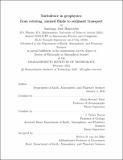Turbulence in geophysics: from rotating, ionized fluids to sediment transport
Author(s)
Benavides, Santiago José
DownloadThesis PDF (15.51Mb)
Advisor
Flierl, Glenn Richard
Perron, J. Taylor
Terms of use
Metadata
Show full item recordAbstract
Part I: "Turbulence in the semiconducting regions of gas giant planets." The 'semiconducting' regions of gas giant planets, which lie between the fully ionized and electrically-neutral regions, have three distinct properties that make the dynamical nature of their flows unique. They are (i) partially-ionized, (ii) subject to rotation and a strong background magnetic field, and (iii) poor electrical conductors. In this Part, I employ a series of idealized direct numerical simulations to explore the impact that each of these properties has on localized turbulent flow, and consider the implications for realistic atmospheres. In Chapter 2, I show that, despite being partially-ionized, the flow in these regions can be treated as a single-species magnetohydrodynamic (MHD) fluid and that collisional heating is likely negligible. Chapter 3 demonstrates that the combination of a strong background magnetic field and a misaligned rotation axis results in the suppression of the inverse cascade, with possible implication for the formation of jets in such atmospheres. Finally, in Chapter 4, I show that the use of an 'MHD drag' fails once the time-scale associated with Lorentz force becomes shorter than the dynamical time-scale in the system.
Part II: "Intermittency in bed load sediment transport."
Sediment transport by wind or water near the threshold of grain motion is dominated by rare transport events. This type of intermittency, termed 'on-off' intermittency, makes it difficult to calibrate sediment transport laws, or to define an unambiguous threshold for grain entrainment, both of which are crucial for predicting sediment transport rates. In Part II of this thesis, I use a combination of laboratory flume experiments and a simple stochastic model to capture the on-off intermittent statistics of bed load sediment transport near the threshold of motion. In Chapter 5 I use the stochastic model to estimate the threshold of grain motion in a novel way and quantify the strength of the shear stress fluctuations. Further analysis of the experiments in Chapter 6 reveals the physical origin of the intermittency and demonstrates that the on-off intermittency lies in the velocity of the grains which are rolling on the bed.
Date issued
2022-02Department
Massachusetts Institute of Technology. Department of Earth, Atmospheric, and Planetary SciencesPublisher
Massachusetts Institute of Technology